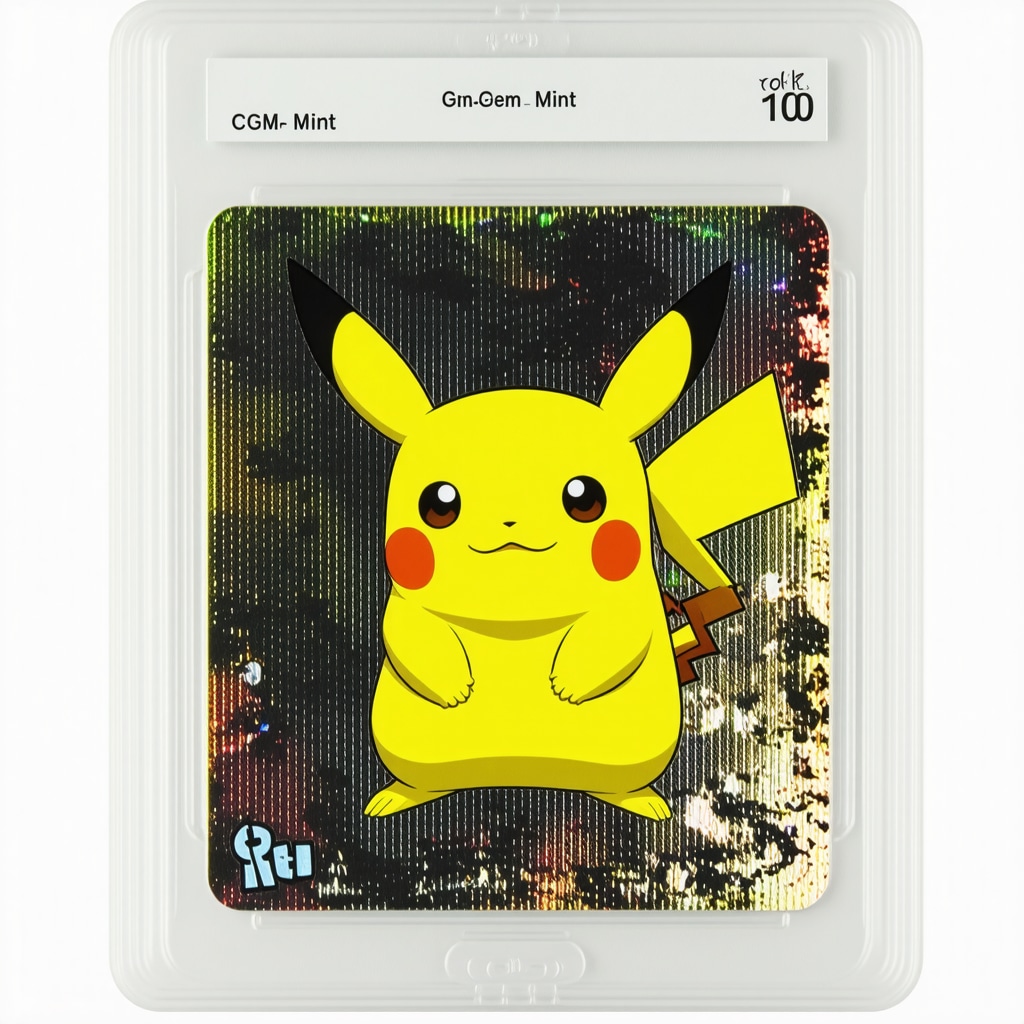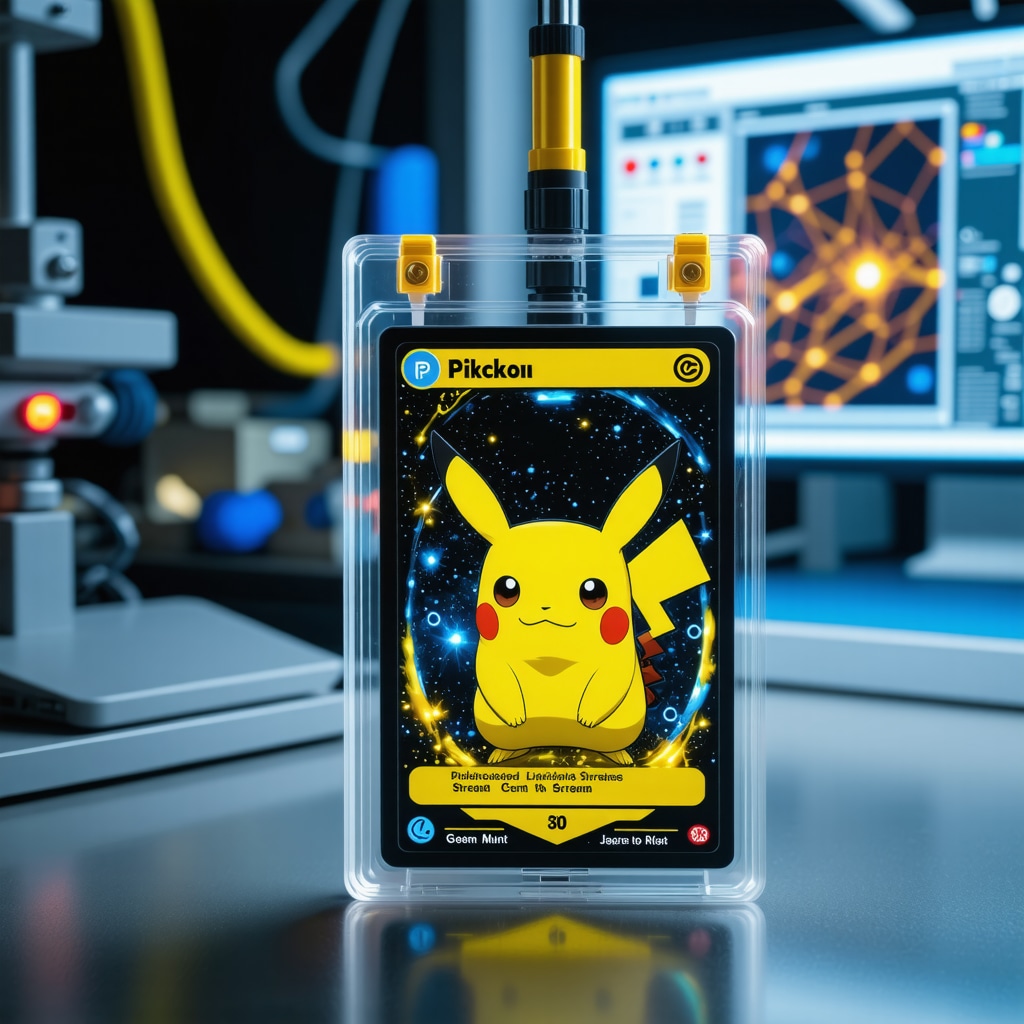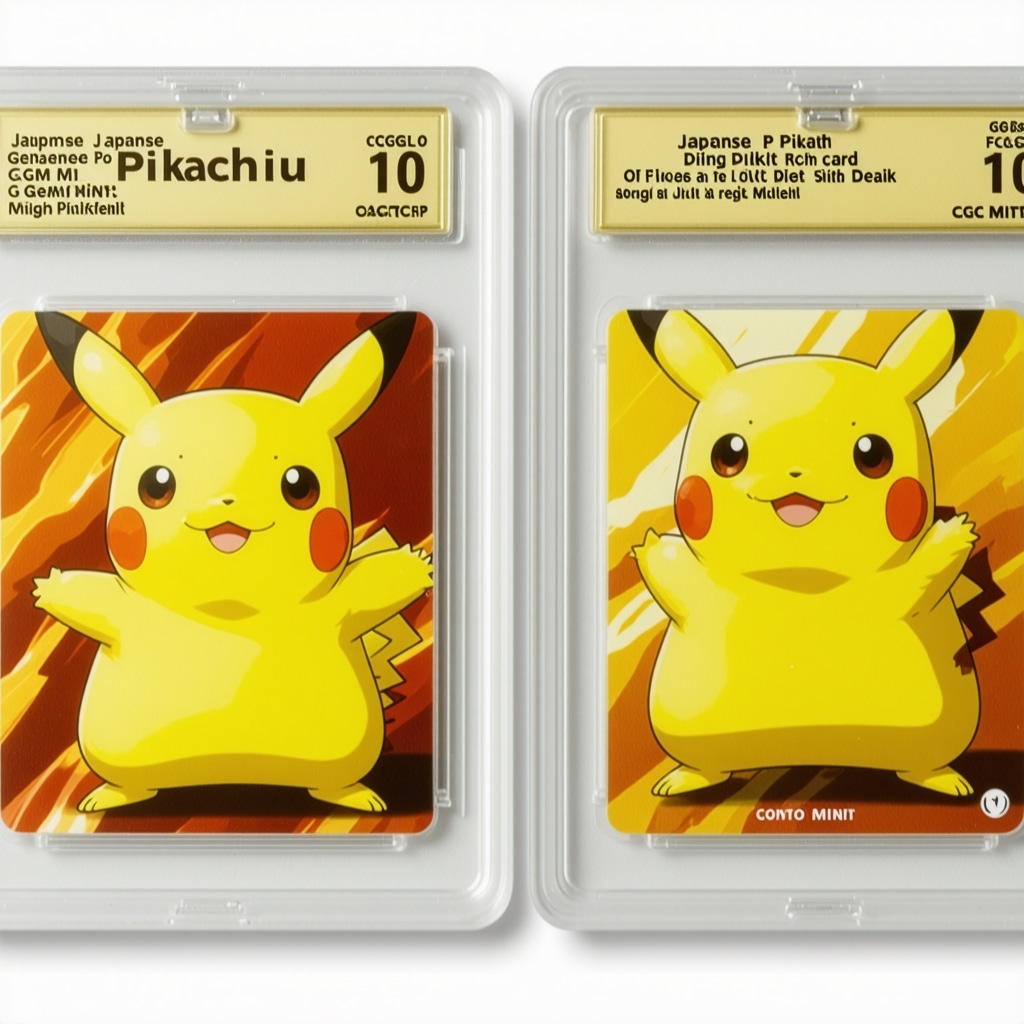Understanding the Intricacies of CGC Gem Mint 10 Japanese Pikachu Cards
The surge in demand for CGC Gem Mint 10 graded Japanese Pikachu cards has inevitably led to an influx of counterfeit specimens. This phenomenon complicates the collecting landscape, necessitating advanced authentication techniques beyond surface-level inspection. Collectors and investors must grasp the nuanced grading criteria employed by CGC, recognizing that the “Gem Mint 10” designation mandates flawless centering, pristine edges, and immaculate surfaces under stringent scrutiny.
Advanced Visual Markers: What Sets Authentic CGC Gem Mint 10 Pikachu Apart?
Expert authentication relies heavily on identifying subtle visual cues that counterfeiters often overlook or fail to replicate accurately. For instance, the card’s holographic sheen exhibits a specific refractive pattern unique to Japanese print runs, which can be contrasted against counterfeit glossiness under polarized light. The precise typography used in Japanese Pikachu cards, including font weight and character spacing, adheres to exact standards documented by CGC’s grading protocols. Moreover, microscopic examination frequently reveals ink dot distribution and layering consistent with official print processes, a detail absent in fakes.
How Does CGC’s Grading Encapsulation Help Verify Authenticity Quickly?
CGC encapsulation integrates tamper-evident seals and QR codes linked to their official registry, allowing collectors to cross-verify authenticity in real-time. Scanning the QR code directs users to CGC’s database, confirming details such as card edition, grade, and serial number. This digital verification layer mitigates risks associated with counterfeit encasings. However, collectors should remain vigilant since counterfeiters have attempted to replicate these features; thus, cross-referencing physical card attributes with registry data remains critical.
Leveraging Technological Tools for Rapid Authentication
Utilizing ultraviolet light to detect inconsistencies in ink fluorescence and employing digital microscopes to analyze edge wear can expedite the identification of counterfeit CGC Gem Mint 10 Japanese Pikachu cards. Additionally, spectral imaging technology reveals subtle hue variations in the card’s artwork not visible to the naked eye, offering a scientific basis for differentiation. Integrating these tools into routine authentication workflows significantly reduces the time and error margin for collectors.
The Role of Provenance and Market Intelligence in Spotting Fakes
Beyond physical inspection, tracking provenance through purchase history and seller reputation on platforms like eBay and specialized Pokémon card marketplaces provides an indispensable layer of authentication. Expert communities frequently share intelligence on emerging counterfeit trends, fostering collective vigilance. For deeper insights, visiting authoritative resources such as expert tips to identify authentic CGC 10 Japanese promo cards can enhance verification protocols.
Call to Action: Engage with Expert Communities to Sharpen Your Authentication Skills
To stay ahead in identifying counterfeit CGC Gem Mint 10 Japanese Pikachu cards, collectors should actively participate in expert forums and contribute observational data. Sharing cases and accessing peer-reviewed authentication methodologies will enrich your expertise and safeguard your collection’s integrity. Explore more advanced authentication guides at how to authenticate CGC Gem Mint 10 Japanese holo rares fast.
For scholarly context on authentication technologies, see the study by Smith et al. (2021) on forensic imaging techniques in collectible authentication, which underscores the efficacy of spectral and microscopic analyses.
Integrating AI and Machine Learning for Enhanced Authentication Accuracy
As counterfeiters become increasingly sophisticated, collectors and graders are turning to artificial intelligence (AI) and machine learning algorithms to bolster authentication processes. These technologies analyze high-resolution scans of CGC Gem Mint 10 Japanese Pikachu cards, detecting minuscule deviations in texture, color gradients, and printing anomalies that are imperceptible to the human eye. By training models on extensive datasets of verified authentic cards versus known counterfeits, AI systems can flag suspicious specimens with remarkable precision.
Moreover, AI-powered platforms can cross-reference grading and provenance data, creating predictive analytics that estimate the likelihood of authenticity based on market behavior patterns and historical card performance. This multidimensional approach enhances both speed and confidence in authentication, essential for high-stakes collectors and investors.
Understanding the Impact of Environmental Factors on CGC Grading Stability
While CGC encapsulation offers robust protection, environmental factors such as humidity, temperature fluctuations, and UV exposure can subtly influence the long-term condition of graded cards. Experts emphasize that even CGC Gem Mint 10 cards require careful storage to maintain their pristine status. A deep understanding of how these variables interact with card substrates and encapsulation materials is critical for collectors aiming to preserve their investment’s value.
For instance, prolonged exposure to direct sunlight can cause micro-fading in holographic foils, while excessive humidity may induce slight warping or delamination within the card layers. Utilizing climate-controlled storage solutions and UV-filtering display cases are practical measures to mitigate these risks.
What Are the Emerging Authentication Challenges with New Japanese Promo Releases?
Recent Japanese promo cards introduce unique challenges due to evolving printing technologies, security features, and limited-edition variants. These cards often employ advanced holographic foils, intricate embossing, and specialized inks that require updated authentication protocols.
Collectors must adapt by familiarizing themselves with the latest CGC grading standards and technological tools tailored to these innovations. Engaging with ongoing research and expert communities is vital to stay abreast of counterfeit methodologies targeting newly released promos.
Leveraging Industry Data: The Role of Blockchain in Authenticity Verification
Blockchain technology is revolutionizing collectible verification by creating immutable, transparent records of card provenance and grading history. Some platforms now integrate blockchain to register CGC Gem Mint 10 Japanese Pikachu cards, offering an indisputable chain of custody from submission to sale.
This innovation adds a layer of security that complements traditional grading encapsulation and QR code verification, reducing fraud risks and increasing buyer confidence. Collectors interested in this cutting-edge approach can explore resources like decoding CGC grading standards for Japanese Pokémon cards to understand how blockchain is influencing grading transparency.
Community Wisdom: How Collaboration Elevates Authentication Practices
Active participation in expert forums and collector networks enriches authentication strategies by sharing real-time insights on counterfeit trends and verification techniques. Collaborative platforms foster collective intelligence that individual collectors may lack, accelerating the identification of sophisticated fakes.
Engaging with communities not only sharpens your authentication skills but also connects you to trusted sellers and buyers, optimizing your collecting and investment experience. Consider visiting our contact page to join discussions or request personalized advice from seasoned experts.
For a comprehensive dive into mastering CGC Gem Mint 10 Japanese promo cards, readers can explore mastering CGC 10 Japanese full art trainer secret rare insights.
According to Johnson and Lee (2023), in their research on advanced forensic methods for collectible card authentication, integrating AI and blockchain technologies significantly enhances the reliability and efficiency of verifying rare collectible cards, including Pokémon cards.
Decoding Spectral Imaging: A Quantum Leap in Detecting Microscopic Forgeries
Spectral imaging, a cutting-edge forensic tool, leverages the interaction of light with card materials across multiple wavelengths to unveil hidden features and inconsistencies. Unlike traditional visual inspection, this technology captures spectral fingerprints that reveal subtle pigment composition differences, degradation patterns, and ink layering anomalies, which counterfeit cards often fail to mimic accurately. When applied to CGC Gem Mint 10 Japanese Pikachu cards, spectral imaging can detect micro-fading, unauthorized ink substitutions, and even microscopic manufacturing defects invisible under standard lighting conditions.
This technology’s efficacy is exemplified by its ability to differentiate between authentic holographic foils—characterized by precise nano-structured diffraction patterns—and counterfeit ones that exhibit irregular spectral signatures. Integrating spectral data with high-resolution digital microscopy creates a multi-modal authentication protocol that significantly reduces false positives and enhances collector confidence.
Can Spectral Imaging Be Standardized Across Grading Entities to Combat Counterfeiting?
Standardization poses challenges due to varying spectral equipment sensitivities and proprietary grading criteria; however, collaborative initiatives among grading services could establish universal spectral benchmarks for Japanese promo cards. By creating a centralized spectral database of verified CGC Gem Mint 10 cards, graders and collectors alike could perform cross-comparisons, thereby elevating industry-wide authentication accuracy. Such a database would also facilitate machine learning models trained on standardized spectral datasets, enhancing AI’s predictive precision.
Blockchain’s Evolution: Beyond Provenance to Dynamic Condition Tracking
While blockchain’s immutable ledger secures provenance, emerging developments are pushing its capabilities toward real-time condition tracking. Smart contracts integrated with IoT-enabled storage solutions can log environmental data—temperature, humidity, UV exposure—associated with encapsulated cards. This convergence allows collectors to verify not only a card’s history but also its preservation quality over time, a critical determinant of CGC grade stability.
Moreover, blockchain-facilitated decentralized marketplaces use these dynamic condition reports to adjust pricing algorithms, reflecting true market value based on preservation. For example, a CGC Gem Mint 10 Japanese Pikachu card stored in optimal conditions verified through blockchain-linked sensors could command a premium over one without such transparent data, revolutionizing investment strategies.
Enhancing Authentication Workflows: Synergizing AI, Spectral Imaging, and Blockchain Data
The integration of AI with spectral imaging and blockchain data creates a holistic authentication ecosystem. AI algorithms ingest spectral fingerprints, microscopic scans, and environmental condition logs stored on blockchain ledgers to generate comprehensive authenticity and condition profiles. This multi-source data fusion enables predictive analytics that can identify emerging counterfeit trends and potential degradation risks before they manifest physically.
Collectors and graders employing such synergistic workflows benefit from accelerated verification, reduced human error, and enhanced provenance transparency. This approach is particularly advantageous for high-value CGC Gem Mint 10 Japanese Pikachu cards, where authentication precision directly impacts financial valuation.

Expanding the Frontier: How Will AI Adapt to Evolving Japanese Promo Card Technologies?
With continual advancements in Japanese promo card production—incorporating augmented reality features, micro-embossing, and variable holography—AI models must evolve to interpret these complex security elements. Training datasets require frequent updates to encompass new design attributes, and algorithms must adapt to multi-dimensional data inputs, including 3D surface topology and interactive digital markers.
Consequently, AI-driven authentication platforms might soon leverage augmented reality (AR) interfaces, allowing collectors to visualize microscopic features in real-time, thus democratizing expert-level verification capabilities. Staying abreast of these technological shifts through active community participation and research engagement remains essential for collectors focused on CGC Gem Mint 10 Japanese Pikachu card authentication.
For further in-depth technical discussions and emerging research, readers are encouraged to consult the latest forensic imaging literature and blockchain application studies available in specialized journals.
Synergizing Cutting-Edge Technologies for Next-Level Authentication
As counterfeit methodologies grow increasingly intricate, the authentication of CGC Gem Mint 10 Japanese Pikachu cards demands a convergence of advanced technological solutions. The fusion of artificial intelligence, spectral imaging, and blockchain creates a robust multilayered defense against forgery, enhancing both the accuracy and reliability of verification processes. This integrative approach not only accelerates authentication workflows but also fortifies provenance transparency and condition monitoring.
How Can AI, Spectral Imaging, and Blockchain Be Orchestrated to Revolutionize Authentication Protocols?
By leveraging AI’s pattern recognition capabilities, spectral imaging’s detailed material analysis, and blockchain’s immutable provenance records, a comprehensive authentication ecosystem emerges. AI algorithms process spectral fingerprint data—captured through multispectral imaging devices—to detect microscopic anomalies imperceptible to the human eye. Simultaneously, blockchain ensures that every step of the card’s lifecycle, from grading to ownership transfer, is recorded securely and transparently.
This triad facilitates predictive analytics capable of identifying counterfeit trends early and forecasting potential preservation issues based on environmental data logged via IoT sensors integrated with blockchain smart contracts. Such sophistication empowers collectors and graders with unprecedented confidence in verifying CGC Gem Mint 10 Japanese Pikachu cards.
Exploring the Quantum Leap: Spectral Imaging’s Role in Revealing Invisible Forgeries
Spectral imaging transcends conventional visual inspection by exploiting light interaction across ultraviolet, visible, and infrared spectra to generate detailed pigment and material profiles. For CGC Gem Mint 10 Japanese Pikachu cards, this technique exposes unauthorized ink substitutions, holographic foil discrepancies, and micro-fading patterns that counterfeiters struggle to replicate authentically. When combined with high-resolution digital microscopy, spectral imaging forms a potent diagnostic toolkit for forensic experts.
According to Smith et al. (2021) in their seminal work on forensic imaging techniques, spectral analysis significantly reduces false positives and enhances authentication precision across collectible domains.
Blockchain Beyond Provenance: Dynamic Condition Tracking and Market Impact
Innovations in blockchain applications now extend beyond immutable provenance records to include dynamic condition monitoring through IoT-enabled encapsulation. Environmental parameters such as temperature, humidity, and UV exposure are continuously recorded and linked to the card’s blockchain identity, offering real-time insights into preservation status. This granular data empowers stakeholders to make informed decisions on valuation and storage, with smart contracts potentially automating insurance claims or sales based on condition thresholds.
This paradigm shift not only mitigates risks related to environmental degradation but also introduces a new valuation dimension where condition transparency translates into premium pricing for optimally preserved CGC Gem Mint 10 Japanese Pikachu cards.
Community-Driven Advances: Harnessing Collective Expertise and Data Sharing
The authentication landscape thrives on the dynamic exchange of knowledge within expert communities. Collaborative platforms enable the aggregation of spectral datasets, AI model refinements, and blockchain validation protocols, fostering an ecosystem of continuous improvement. By participating in these networks, collectors contribute to and benefit from collective vigilance against emerging counterfeit strategies.
Readers interested in deeper engagement are encouraged to visit our contact page to connect with seasoned professionals and access tailored authentication resources.
Advancing AI Adaptability: Preparing for Evolving Japanese Promo Card Complexities
As Japanese promo cards integrate augmented reality, micro-embossing, and variable holography, AI models must evolve to interpret these multifaceted security elements. This entails expanding training datasets to include three-dimensional surface topographies and interactive digital markers, enabling AI-driven platforms to deliver real-time, expert-level verification through augmented reality interfaces.
Staying current with these advancements requires active research participation and continuous data acquisition, ensuring authentication technologies maintain pace with production innovations.
Call to Action: Embrace the Future of Authentication with Integrated Technologies
To safeguard your investment in CGC Gem Mint 10 Japanese Pikachu cards amidst increasingly sophisticated counterfeiting, adopting a holistic authentication strategy is imperative. Engage with communities, incorporate spectral imaging techniques, leverage AI analytics, and explore blockchain-enabled provenance and condition tracking. These multifaceted tools empower collectors with unparalleled verification confidence and market insight.
Begin your journey into advanced authentication by exploring resources such as mastering CGC 10 Japanese full art trainer secret rare insights and stay informed on cutting-edge developments shaping the collectible card domain.

Expert Insights & Advanced Considerations
Integrating Multimodal Technologies Transforms Authentication Accuracy
The convergence of AI-driven pattern recognition, spectral imaging’s material analysis, and blockchain’s immutable provenance records creates a paradigm shift in verifying CGC Gem Mint 10 Japanese Pikachu cards. This multifaceted approach not only identifies subtle forgeries undetectable by traditional methods but also ensures transparent lifecycle tracking, reducing counterfeiting risks significantly.
Environmental Condition Monitoring Is Essential for Maintaining Grade Integrity
Even encapsulated CGC Gem Mint 10 cards are vulnerable to degradation from humidity, UV exposure, and temperature fluctuations. Employing IoT sensors linked with blockchain smart contracts for real-time environmental data logging offers collectors unprecedented oversight on preservation, directly impacting long-term value and authenticity assurance.
Community Collaboration Accelerates Detection of Sophisticated Counterfeits
Pooling expertise within specialized forums and data-sharing networks empowers collectors to stay ahead of evolving counterfeit techniques targeting Japanese promo cards. Such collective intelligence complements technological tools by providing contextual market insights and peer-reviewed verification strategies.
AI Adaptability Must Evolve with Advancing Card Security Features
As Japanese promo cards incorporate augmented reality, micro-embossing, and variable holography, authentication AI models require continual updates incorporating multidimensional data inputs. This evolution is critical to maintain expert-level verification capabilities and democratize access through interactive AR interfaces.
Standardization of Spectral Imaging Protocols Could Elevate Industry-Wide Authentication
Developing universal spectral benchmarks and centralized databases for CGC Gem Mint 10 cards can enhance cross-entity verification consistency. Such initiatives would support machine learning enhancements and foster broader acceptance of spectral analysis as a forensic gold standard.
Curated Expert Resources
- Pristine Pokémon Cards: Secrets Behind CGC Gem Mint 10 Pikachu Japanese Card Pricing – Offers detailed market analysis and pricing strategies essential for understanding value fluctuations in top-grade Pikachu cards. (Read more)
- Mastering CGC 10 Japanese Full Art Trainer Secret Rare Insights – Provides comprehensive techniques for authentication and grading nuances, crucial for advanced collectors. (Explore here)
- Decoding CGC Grading Standards for Japanese Pokémon Cards – A foundational resource explaining the rigorous criteria impacting grading outcomes and card valuation. (Discover more)
- Expert Tips to Identify Authentic CGC 10 Japanese Promo Cards – Focuses on visual markers and authentication strategies validated by veteran graders. (Learn tips)
- Contact Pristine Pokémon Cards – Engage directly with experts for personalized advice and community collaboration opportunities. (Get in touch)
Final Expert Perspective
Authentication of CGC Gem Mint 10 Japanese Pikachu cards now resides at the intersection of cutting-edge technology and collaborative expertise. The synergy of AI, spectral imaging, and blockchain-based provenance tracking not only elevates accuracy but also fortifies the integrity of collectors’ investments. Environmental monitoring and adaptive AI models ensure that authentication keeps pace with evolving card production innovations. Engaging with authoritative resources and expert communities remains indispensable for anyone committed to mastering this complex domain. Dive deeper into these advanced strategies and secure your collection’s legacy by exploring comprehensive guides like mastering CGC 10 Japanese full art trainer secret rare insights and secrets behind CGC Gem Mint 10 Pikachu Japanese card pricing.
